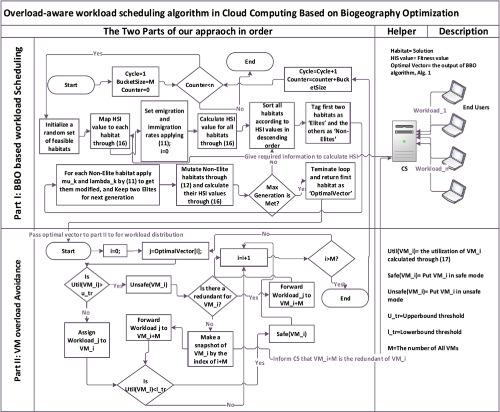当前位置:
X-MOL 学术
›
Int. J. Netw. Manag.
›
论文详情
Our official English website, www.x-mol.net, welcomes your feedback! (Note: you will need to create a separate account there.)
OASM: An overload‐aware workload scheduling method for cloud computing based on biogeographical optimization
International Journal of Network Management ( IF 1.5 ) Pub Date : 2020-02-18 , DOI: 10.1002/nem.2105 Ali Abbasi Tadi 1 , Mohammad Reza Khayyambashi 2 , Hadi Khosravi‐Farsani 3
International Journal of Network Management ( IF 1.5 ) Pub Date : 2020-02-18 , DOI: 10.1002/nem.2105 Ali Abbasi Tadi 1 , Mohammad Reza Khayyambashi 2 , Hadi Khosravi‐Farsani 3
Affiliation

|
With the daily increase in the number of cloud users and the volume of submitted workloads, load balancing (LB) over clouds followed by a reduction in users' response time is emerging as a vital issue. To successfully address the LB problem, we have optimized workload distribution among virtual machines (VMs). This approach consists of two parts: Firstly, a meta‐heuristic method based on biogeographical optimization for workload dispatching among VMs is introduced; secondly, we propose an innovative heuristic algorithm inspired by the “Banker algorithm” that runs in core scheduler to control and avoid VM overloads. The combination of these two (meta‐)heuristic algorithms constitutes an LB approach through which we have been able to reduce the value of the makespan to a reasonable time frame. Moreover, an information base repository (IBR) is introduced to maintain the online processing status of physical machines (PMs) and VMs. In our approach, data stored in IBR are retrieved when needed. This approach is compared with well‐known (non‐)evolutionary approaches, such as round‐robin, max‐min, MGGS, and TBSLB‐PSO. Experimental results reveal that our proposed approach outperforms its counterparts in a heterogeneous environment when the resources are smaller than the workloads. Moreover, the utilization of physical resources gradually increases. Therefore, optimal workload scheduling, as well as the lack of overload occurrence, results in a reduction in makespan.
中文翻译:

OASM:一种基于生物地理优化的云计算过载感知工作负载调度方法
随着云用户数量和提交的工作负载的每天增加,云上的负载平衡(LB)以及随后用户响应时间的减少已成为一个至关重要的问题。为了成功解决LB问题,我们优化了虚拟机(VM)之间的工作负载分配。这种方法包括两个部分:首先,介绍了一种基于生物地理优化的元启发式方法,用于在VM之间分配工作量;其次,我们提出了一种创新的启发式算法,该算法启发于在核心调度程序中运行的“银行家算法”,以控制和避免虚拟机过载。这两种(元)启发式算法的组合构成了一种LB方法,通过该方法,我们已经能够将有效期的值减小到合理的时间范围。此外,引入了一个信息库(IBR)以维护物理机(PM)和VM的在线处理状态。在我们的方法中,可以在需要时检索存储在IBR中的数据。将该方法与著名的(非)进化方法进行了比较,例如循环法,最大最小值法,MGGS法和TBSLB-PSO法。实验结果表明,在资源少于工作负载的情况下,我们提出的方法在异构环境中的性能优于同类方法。而且,物理资源的利用逐渐增加。因此,最佳的工作负载调度以及缺少过载的发生都会导致制造期的减少。将该方法与众所周知的(非)进化方法进行了比较,例如循环法,最大最小值法,MGGS法和TBSLB-PSO法。实验结果表明,在资源少于工作负载的情况下,我们提出的方法在异构环境中的性能优于同类方法。而且,物理资源的利用逐渐增加。因此,最佳的工作负载调度以及缺少过载的发生都会导致制造期的减少。将该方法与众所周知的(非)进化方法进行了比较,例如循环法,最大最小值法,MGGS法和TBSLB-PSO法。实验结果表明,在资源少于工作负载的情况下,我们提出的方法在异构环境中的性能优于同类方法。而且,物理资源的利用逐渐增加。因此,最佳的工作负载调度以及缺少过载的发生都会导致制造期的减少。
更新日期:2020-02-18
中文翻译:

OASM:一种基于生物地理优化的云计算过载感知工作负载调度方法
随着云用户数量和提交的工作负载的每天增加,云上的负载平衡(LB)以及随后用户响应时间的减少已成为一个至关重要的问题。为了成功解决LB问题,我们优化了虚拟机(VM)之间的工作负载分配。这种方法包括两个部分:首先,介绍了一种基于生物地理优化的元启发式方法,用于在VM之间分配工作量;其次,我们提出了一种创新的启发式算法,该算法启发于在核心调度程序中运行的“银行家算法”,以控制和避免虚拟机过载。这两种(元)启发式算法的组合构成了一种LB方法,通过该方法,我们已经能够将有效期的值减小到合理的时间范围。此外,引入了一个信息库(IBR)以维护物理机(PM)和VM的在线处理状态。在我们的方法中,可以在需要时检索存储在IBR中的数据。将该方法与著名的(非)进化方法进行了比较,例如循环法,最大最小值法,MGGS法和TBSLB-PSO法。实验结果表明,在资源少于工作负载的情况下,我们提出的方法在异构环境中的性能优于同类方法。而且,物理资源的利用逐渐增加。因此,最佳的工作负载调度以及缺少过载的发生都会导致制造期的减少。将该方法与众所周知的(非)进化方法进行了比较,例如循环法,最大最小值法,MGGS法和TBSLB-PSO法。实验结果表明,在资源少于工作负载的情况下,我们提出的方法在异构环境中的性能优于同类方法。而且,物理资源的利用逐渐增加。因此,最佳的工作负载调度以及缺少过载的发生都会导致制造期的减少。将该方法与众所周知的(非)进化方法进行了比较,例如循环法,最大最小值法,MGGS法和TBSLB-PSO法。实验结果表明,在资源少于工作负载的情况下,我们提出的方法在异构环境中的性能优于同类方法。而且,物理资源的利用逐渐增加。因此,最佳的工作负载调度以及缺少过载的发生都会导致制造期的减少。



























 京公网安备 11010802027423号
京公网安备 11010802027423号